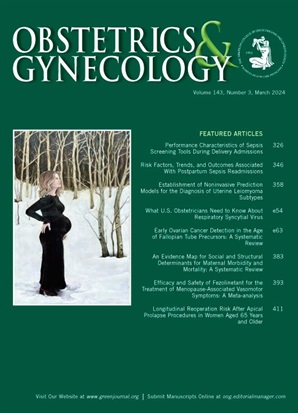Cost Effectiveness of the Reverse Sequence Algorithm Compared With the Traditional Algorithm for Syphilis Screening Among Pregnant Women.
IF 4.7
2区 医学
Q1 OBSTETRICS & GYNECOLOGY
引用次数: 0
Abstract
OBJECTIVE The traditional syphilis screening algorithm, which involves a nontreponemal assay followed by confirmatory treponemal testing, has been challenged by an alternative approach known as the reverse sequence algorithm. The latter reverses the order of the tests and incorporates a second treponemal test for discordant results. Although the reverse sequence may offer operational advantages, there is a need for formal cost-effectiveness analyses to compare these two syphilis screening alternatives. METHODS We conducted cost-effectiveness analyses from the health care sector perspective to compare the reverse sequence with the traditional algorithm. We employed a decision tree for pregnant women in prenatal care that included the possibility of congenital syphilis outcomes. A simulated a cohort of 10,000 people was screened over 1 year to estimate total costs and quality-adjusted life-years (QALYs) under each algorithm. We estimated incremental cost-effectiveness ratios (ICERs). Sensitivity analyses were performed to identify influential parameters affecting the ICERs and to conduct scenario analyses. RESULTS During prenatal care, the reverse sequence detected four more cases, overtreated 185 more individuals, and prevented 0.42 more congenital syphilis cases (ICER $463,735/QALY gained), when compared with the traditional algorithm. Sensitivity analyses revealed that syphilis prevalence had the greatest effect on the ICER. To achieve ICERs below $50,000/QALY gained, syphilis prevalence would need to exceed 6% during prenatal care. CONCLUSION Our analysis indicates that, under likely parameter values, the reverse sequence algorithm is equally effective but more costly than the traditional algorithm and therefore not cost effective. Although treponemal test automation may offer potential savings in laboratory costs, these are outweighed by overtreatment costs.逆向序列算法与传统算法在孕妇梅毒筛查中的成本效益比较
传统的梅毒筛查算法,包括非密螺旋体检测,然后是确证性密螺旋体检测,已经被一种称为反向序列算法的替代方法所挑战。后者颠倒了测试的顺序,并纳入了第二次螺旋体测试不一致的结果。虽然反向顺序可能提供操作优势,但有必要进行正式的成本效益分析,以比较这两种梅毒筛查方法。方法从医疗卫生部门角度进行成本-效果分析,将逆向排序与传统算法进行比较。我们采用了孕妇产前护理的决策树,包括先天性梅毒结局的可能性。在1年的时间里对1万人进行了模拟筛选,以估计每种算法下的总成本和质量调整生命年(QALYs)。我们估算了增量成本-效果比(ICERs)。进行敏感性分析以确定影响ICERs的影响参数并进行情景分析。结果在产前护理中,反向排序比传统算法多检出4例,多过度治疗185例,多预防先天性梅毒0.42例(ICER $463,735/QALY)。敏感性分析显示,梅毒患病率对ICER的影响最大。为了使ICERs低于5万美元/质量质量,产前护理期间的梅毒患病率需要超过6%。结论我们的分析表明,在似然参数值下,反向序列算法与传统算法同样有效,但成本较高,因此不具有成本效益。尽管密螺旋体检测自动化可能提供潜在的实验室成本节约,但这些成本被过度治疗成本所抵消。
本文章由计算机程序翻译,如有差异,请以英文原文为准。
求助全文
约1分钟内获得全文
求助全文
来源期刊

Obstetrics and gynecology
医学-妇产科学
CiteScore
11.10
自引率
4.20%
发文量
867
审稿时长
1 months
期刊介绍:
"Obstetrics & Gynecology," affectionately known as "The Green Journal," is the official publication of the American College of Obstetricians and Gynecologists (ACOG). Since its inception in 1953, the journal has been dedicated to advancing the clinical practice of obstetrics and gynecology, as well as related fields. The journal's mission is to promote excellence in these areas by publishing a diverse range of articles that cover translational and clinical topics.
"Obstetrics & Gynecology" provides a platform for the dissemination of evidence-based research, clinical guidelines, and expert opinions that are essential for the continuous improvement of women's health care. The journal's content is designed to inform and educate obstetricians, gynecologists, and other healthcare professionals, ensuring that they stay abreast of the latest developments and best practices in their field.
 求助内容:
求助内容: 应助结果提醒方式:
应助结果提醒方式:


